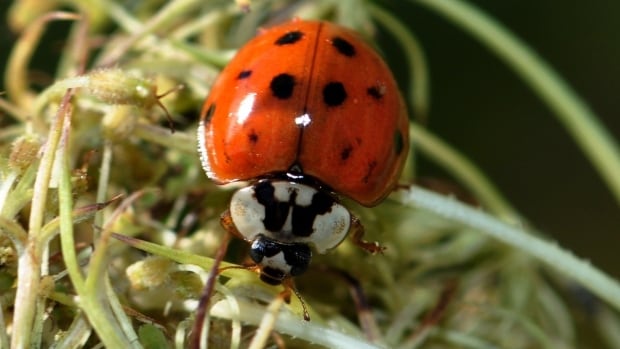When Nancy McLean had supper last week, she found herself surrounded by dozens of tiny, polka-dotted crawlers in her farmhouse in Nova Scotia’s Pictou County.
“It wasn’t too disturbing, but it was unusual because these lady beetles are only around and under certain types of conditions,” she said.
The biology professor is not the only one noticing plenty of Asian lady beetles, which resemble a ladybug but have a slightly orange tint and a white head. The invasive species often gravitate toward buildings in the fall.
The ladybug look-alikes were brought from Asia to the U.S. in the 1970s to prey on aphids, another insect that is particularly troublesome in soybean crops.
They have since expanded their reach into the Maritimes, where they have become a common sight before temperatures drop. McLean said the insects become more active on warm days since they use them to find refuge.
“It was a beautiful day on both Saturday and Sunday, so these lady beetles were trying to find a place to hang out for the winter so they would survive,” she said.

An invasive bug’s life
Robert Johns, a forest insect ecologist for the Canadian Forest Service in Fredericton, said the Asian lady beetle is outside for most of the spring and summer feeding off of soft-bodied insects.
Unlike ladybugs, these beetles congregate and hibernate together during the winter. Johns said the fall is the time when they look for a cozy home for the colder months, which is how they end up inside buildings.
But the problem with this invasive species, he said, is that it has no natural predators thanks to the smelly, yellowish substance it produces for self-defence.
“Birds, which would typically be the things that would eat them, they get it in their mouth and they basically spit it out,” said Johns.
This lack of predation means the Asian lady beetle can easily outcompete native species. Johns said some farmers tolerate them for their role in controlling pests because they prey on aphids.
“This [invasive species] is a relatively minor one in the sense that it still attacks things like pests that are on crops,” said Johns.
He wasn’t aware of any work underway to track their specific numbers in the region.
Getting rid of them
Johns said getting rid of an invasive bug species like the Asian lady beetle at a larger scale is “impossible, essentially.”
“If they had those ways to deal with insects, they wouldn’t have probably introduced them in the first place, right?”
In the past, one possible solution was to introduce a natural predator. However, this is how these insects arrived. So Johns said bringing another species to prey on this beetle could create more problems.

Pesticides are not effective against them and squishing them releases that same stinky substance that repels birds.
McLean said these bugs are just a nuisance for homeowners, but if you really want to get rid of them, she recommends a simple solution that avoids the smell that comes from smooshing them: vacuuming them up.
“They’re not terrible. They don’t cause any diseases,” said McLean, who added they usually don’t bite and if they do, it is not toxic or painful.
“You can let them crawl all over you.”







